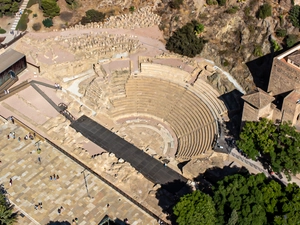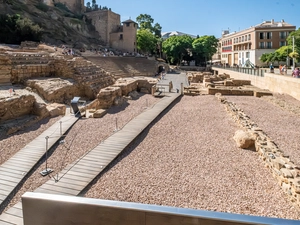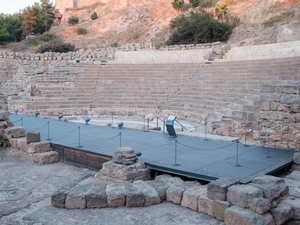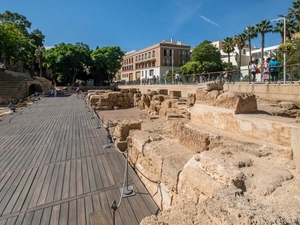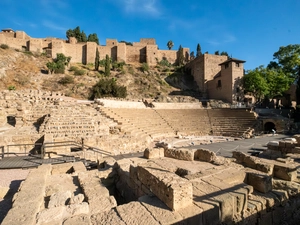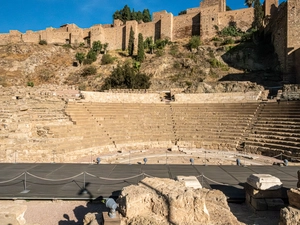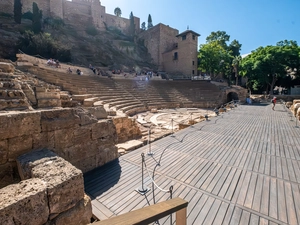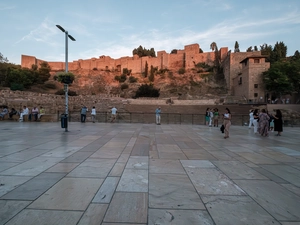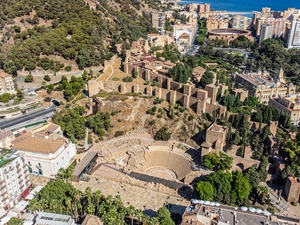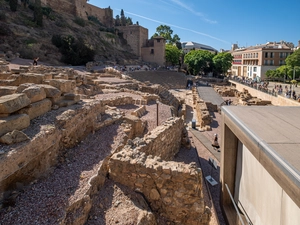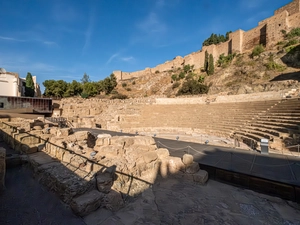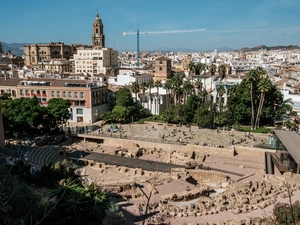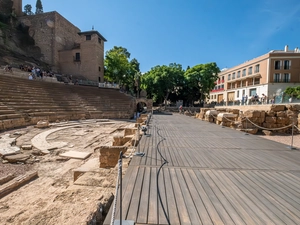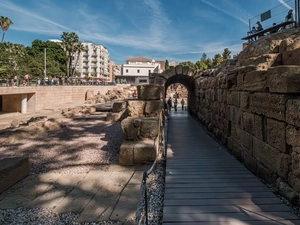Roman Theater of Malaga
Find a transport route
| The meaning of the object: | Archaeological / prehistoric site |
| Country: | Spain |
| State District: | Malaga |
| State: | Andalusia |
| City: | Málaga |
| Neighbourhood: | Centro Histórico |

Description
The Roman Theatre in Málaga is one of the few surviving architectural monuments of the Roman presence in the city. It was built at the beginning of the first century AD, i.e. during the period of the Roman Empire, when it was actively developing and many new buildings were being constructed.
Once in front of the Roman Theatre there were baths from the times of the first Roman Republic, only the remains of the stone floor have been preserved. The theatre is partly built on the remains of these baths.
Description
The Roman theatre in Málaga, built in the 1st century BC during the time of Emperor Augustus, is one of the most important archaeological monuments of Andalusia and one of the oldest Roman theatres on the Iberian Peninsula. Located at the foot of the Alcazaba fortress, the theatre was originally used for theatrical performances, public meetings and other cultural events, making it an important social centre in ancient Roman Malaga (Malaca).
Architecturally, the theatre blends in with the natural landscape - its stands (cavei) are built into the hillside, which not only provided comfortable seating for the audience, but also improved the theatre's acoustics. The theatre was designed according to typical Roman architectural principles: it had an orchestra, a stage (scena) and a rich decorative façade decorated with columns and arches. Although most of these elements have not survived to this day, restoration work has made it possible to partially restore the original features of the theatre.
After the 3rd century AD, the theatre was abandoned and gradually destroyed, and its stones were used for the construction of other buildings, including the Alcazaba, the fortress located above the theatre. The site was accidentally discovered in 1951 during the construction of the House of Culture, which led to the beginning of extensive archaeological excavations and restoration.
Today, the Roman Theatre in Málaga is not only a valuable archaeological site, but also serves as an active cultural centre. It regularly hosts theatre productions, concerts and other events, allowing residents and visitors to Málaga to experience the city's ancient heritage. The theatre is open to the public all year round, offering a unique opportunity to see one of the most important testimonies of the Roman presence in Spain.
For those interested in ancient history and architecture, the Roman Theatre in Málaga is a must-see. Its central location in the city makes it accessible to all tourists, and its rich history and architectural features allow for a deeper understanding of the cultural heritage of Málaga and the Roman era in Spain.
History
The Roman theatre in Málaga was used for two centuries, until the 3rd century AD, when it was abandoned. Over time, the theatre was partially destroyed and looted. During the late Roman period and the early Middle Ages, its area was used for various economic purposes, including salt production and fish salting. Pools used for this production have been discovered, which supports the hypothesis that the theatre space was used for economic activities.
For some time, part of the theatre was indeed used as a necropolis, as evidenced by the tombs and burials found in the excavations. In addition, some of the building materials from the Roman theatre were used in the construction of the Alcazaba fortress in the 11th century, reflecting the common practice of reusing ancient structures.
For many centuries, the Roman theatre in Málaga was buried under layers of earth, streets and houses built on the slope of the Alcazaba. During the construction of the House of Culture in 1951, a monumental structure was accidentally discovered, which was initially mistaken for part of a Roman wall. However, subsequent archaeological research revealed that it was a Roman theatre, as tribunes and other characteristic elements were found.
The main part of the theatre was under the foundations of the House of Culture, which created difficulties for excavations. After much discussion and debate, the building of the House of Culture was demolished, allowing for extensive archaeological excavations, which are still ongoing. As a result of these excavations, the theatre was partially restored and opened to the public in 2011 after significant restoration work.
Today, the Roman Theatre in Málaga is one of the city's main tourist attractions and an important cultural heritage of Spain, protected as a national monument. Its discovery was an important event in the archaeology of the region, as the theatre sheds light on the Roman period in Malaga's history.
Architecture
The Roman theatre in Málaga was built in the 1st century BC, probably during the reign of Emperor Augustus. Although there is no exact record of the designer, there is no historical evidence to confirm that Vitruvius was the architect.
The theatre does make use of the natural topography of the hill where the cavaeus (seats for the audience) are located. Most of the cavaeus were built into the hillside, with the remainder supported by man-made structures.
The theatre had a stage (skena) that was about 31 metres wide and an orchestra about 15 metres in diameter.
The part of the auditorium seats closest to the stage (the first rows), known as the proscenium, was reserved for important guests and may have had wooden floors and marble panelling.
The auditoriums were divided into three sectors (tiers) by aisles, and arched openings and tunnels (vomitoria) were used for audience access to seats and exit to the stage.
Major corrections:
- Architect Vitruvius: There is no mention of Vitruvius as the designer of the Roman theatre in Malaga in sources related to the Roman theatre in Malaga. This name was probably added erroneously, as Vitruvius was known as an architect and theorist, but his association with this particular project is unconfirmed.
- Date of construction: the Roman theatre in Malaga was built in the 1st century BC, probably during the reign of Emperor Augustus. This is consistent with the archaeological evidence and the history of the city during that period.
- Use of the relief of the hill: This is indeed typical of Roman theatres, including the theatre in Malaga. Most of the auditorium seats (cavei) are built into the hillside, making use of the natural topography.
- Stage and orchestra: The dimensions of the stage and orchestra (31 metres and 15 metres respectively) correspond to the typical parameters of Roman theatres and are confirmed by archaeological evidence.
- Grandstand for important guests: Such grandstands existed, and in some theatres they may indeed have been finished in marble or had wooden elements.
- Sectors and arched openings: The division of grandstands into sectors and the presence of arched openings (vomitoria) for audience access is also typical of Roman theatres and is confirmed by archaeological excavations.
Excursions
To learn interesting facts about Roman times, details about the construction and use of the Roman Theatre, you can book a guided tour during your visit.
The Roman Theatre is one of the most popular and frequently visited attractions in Málaga. To help visitors and make the tour more interesting, an information centre was built next to the Roman Theatre in 2010. It was erected in the form of a prima of steel, glass and wood, the design of this unique building was created by Spanish architect Antonio Tejedor. The information centre contains information about excavations, interesting finds.
How to visit
Entrance to the Roman Theatre in Málaga is free of charge.
Opening hours:
- Tuesday - Saturday from 10-00 to 18-00,
- Sunday and holidays from 10-00 to 16-00.
- Monday is a day off.
Closed: 1 and 6 January, 1 May, 24, 25 and 31 December. On other national, regional and/or local holidays, please check opening times by
email: TRomanoMalaga.aaiicc@juntadeandalucia.es
There is no charge to visit and no advance ticket reservation is required. However, for guided tours, pre-booking is recommended by calling 951 501 115 or by email.
Visitors will cease entry 30 minutes before closing time.
How to get there
The Roman Theatre in Málaga is located in the city centre at Calle Alcazabilla, 8, 29015 Málaga, next to the Alcazaba Fortress. The theatre is easily accessible on foot, as it is just a short walk from major attractions such as the Cathedral and Marques de Larios Street.
If you prefer public transport, the nearest bus stop is called ‘Alcazabilla (Teatro Romano)’, serving routes C1 and C2. It is just a two-minute walk from the theatre. Another convenient stop is ‘Paseo del Parque,’ which is about a 5-minute walk away and is served by many bus routes, including the 1, 4, 14, and 37.
For those who prefer the metro, the nearest station is Atarazanas, located 750 metres from the theatre. It can be reached on foot in about 10 minutes.
If you plan to get there by car, it's worth bearing in mind that parking is limited in the city centre. However, paid parking is available near the theatre, such as on Paseo de Reding and Calle Victoria.
The Roman Theatre is open to the public all year round and admission is free, making it a popular destination for tourists and locals alike.
What to visit nearby
The Roman Theatre in Málaga is located in the historic centre of the city, and there are many interesting sights to visit around it. First and foremost is the Alcazaba Fortress, which sits directly above the theatre. This 11th century Moorish fortress palace offers spectacular views of the city and the sea, as well as unique architecture and gardens.
Another important historical attraction is the Castle of Gibralfaro, which sits on top of the hill above the Alcazaba. The castle can be reached on foot or by bus and offers stunning panoramic views of Málaga.
Also worth a visit is the Picasso Museum, just a short walk from the theatre. This museum has an extensive collection of works by the famous Málaga-born artist.
Nearby is also the Cathedral of Málaga, known as La Manquita (meaning ‘The One-armed One’ due to the fact that one of the towers was never completed). This cathedral combines both Renaissance and Baroque styles and is stunning in its majestic architecture and interior decoration.
Don't miss the opportunity to stroll along the picturesque Paseo del Parque promenade, where you can enjoy beautiful gardens, sculptures and views of Málaga's harbour.
Thus, around the Roman Theatre in Málaga, you will find many historical and cultural sites that will make your visit rich and interesting.
- Telephone: (+34) 951 50 11 15, (+34) 671 53 92 12
- Email: TRomanoMalaga.aaiicc@juntadeandalucia.es
- Website:
- Address: C/ Alcazabilla, s/n, Distrito Centro, 29015 Málaga
- GPS Coordinates: 36.72127441022829, -4.417019721578746
Opening Hours
| Monday: | Closed |
| Tuesday: | No data |
| Wednesday: | No data |
| Thursday: | No data |
| Friday: | No data |
| Saturday: | No data |
| Sunday: | No data |
Photos
Upload photos
Upload your photos
Videos
Watch video
Sightseeing tours and entertainment
Excursions №1
Excursions №2
Tour information
Immerse Yourself in the World of Unforgettable Travels.
Discover a world of adventures and unforgettable journeys! Our website offers you unique travels, exotic tours, and unusual excursions that turn your dreams into reality. Relaxation at exotic resorts, exploration of secret corners of tropical islands, beach vacations, city tours - here you will find a variety of tours for all preferences and budgets. Perfect for search queries like "exotic travels", "tours to tropical islands", "cultural excursions", and "unforgettable adventures".
✓ Excursion Tours: Explore the cultural heritage of ancient civilizations and the beauty of picturesque nature. These excursions are an excellent choice for those looking for "adventure excursions" and "cultural tourism".
✓ Group and Individual Tours: From secluded spots for peaceful relaxation to bustling city streets – we have tours for every taste and style, from "peaceful relaxation" to "urban adventures".
✓ Guides and Tour Leaders: Our experienced guides will make your journey unforgettable, filling it with unique stories and knowledge, perfect for those looking for "tours with guides" and "excursions with a tour leader".
✓ Online Tour Booking: A simple and secure booking process on our platform ensures the protection of your personal data and convenient choice, ideally suited for queries like "online tour booking" and "secure travel booking".
✓ Deals and Special Offers: Don't miss our attractive discounts and special offers, making your vacation even more economical and memorable, ideal for searching "travel discounts" and "special travel offers".
Every trip booked through our website is the beginning of a new story, full of exciting discoveries and vivid impressions. Start your adventure today and discover the "perfect journey"!
Nearby places
What hotels are nearby
When it comes to planning travel or extended stays, choosing the right accommodation plays a key role. Booking.com offers a wide range of accommodations, including apartments, villas, flats, hostels, and especially hotels for both short-term and long-term rentals.
The service ensures that every customer finds the optimal option near the places they are interested in, whether it be beaches, famous attractions, districts, or entire cities. Booking.com's offerings cater to various tastes and budgets, providing a choice from luxury hotels to cozy apartments.
Hotel accommodation holds a special place in the company's offerings. Hotels available on Booking.com are ideal for both business trips and family vacations, offering various amenities, including restaurants, bars, swimming pools, and spas.
The catalog includes accommodation for any occasion:
- Aparthotel: A combination of apartments and hotel amenities, offering kitchens and more living space.
- Apartment: Ideal for independent travelers, offering home comforts including a kitchen and separate rooms.
- Bed and Breakfast (B&B): Cozy accommodations offering a homely atmosphere and breakfast included.
- Business Hotel: Specialized in amenities for business travelers, including conference rooms and Wi-Fi.
- Boat: A unique living experience on the water, perfect for maritime adventures.
- Camp: Simple accommodations in a natural setting, often with basic amenities.
- Camping: Spots for pitching tents or parking RVs, ideal for nature lovers.
- Capsule Hotel: Popular in Japan, offering small, functional capsules for sleeping.
- Chalet: Wooden houses in the mountains, perfect for winter holidays and ski trips.
- Country House: Offering tranquility and seclusion in the countryside.
- Cruise: Travel on a cruise liner with accommodation in cabins and onboard entertainment.
- Farm Holiday: Accommodation on working farms, offering a unique rural experience.
- Gite: Traditional French vacation homes, usually in the countryside.
- Guest House: Small, cozy houses, often family-run, offering a personal touch.
- Holiday Home: Houses or cottages for family or group vacations.
- Holiday Park: Complexes with various types of accommodation and entertainment on site.
- Homestay: Staying with local residents for cultural immersion.
- Hostel: Budget options with shared rooms and the opportunity to meet other travelers.
- Hotel: A variety of options from budget to luxury, with a wide range of amenities.
- Inn: Traditional, often historical, accommodations with personal service.
- Lodge: Often located in natural or remote areas, offering seclusion and a natural experience.
- Love Hotel: Popular in Japan, designed for short romantic stays.
- Motel: Conveniently located near roads, ideal for travelers by car.
- Resort: Accommodations with a wide range of entertainment and services on site.
- Riad: Traditional Moroccan homes with an inner courtyard, offering a unique cultural stay.
- Ryokan: Traditional Japanese inns, offering a unique experience and local cuisine.
- Villa: Often luxurious homes with privacy, ideal for family groups or large company retreats.
Customers can take advantage of flexible rental conditions, choosing accommodation for one night or an extended period. The search and booking process is greatly simplified thanks to an easy-to-use online interface, allowing you to select dates, type of accommodation, and necessary amenities.
Reasons to choose Booking.com for hotel reservations:
- A wide range of quality hotels.
- Transparent pricing without hidden fees.
- Trustworthy reviews from real customers.
- 24/7 customer support.
Thus, choosing Booking.com for hotel bookings is a decision that thousands of satisfied customers have already appreciated. Book your ideal hotel on Booking.com and enjoy a comfortable and carefree stay.
Tips:
- Budget: Determine your budget for rent or hotel stay. This will help narrow down the search to options you can afford.
- Location: Choose a convenient location for you, based on the purpose of your trip. For example, if you are traveling for tourism, choose accommodation near major attractions. For business trips, options near business centers are suitable.
- Amenities and Services: Decide which amenities are important to you. This could be Wi-Fi, a kitchen, a washing machine, or a fitness center.
- Reviews: Read reviews from other guests to learn about the real quality of the accommodation or hotel.
- Accommodation Rules: Check the accommodation rules, especially if traveling with pets or children.
- Booking and Cancellation: Check the booking conditions and cancellation policy. Some options offer free cancellation, which can be important in case of plan changes.
- Safety: Ensure the safety of the area and the accommodation itself.
- Transport: Consider the availability of public transport or parking if you are traveling by car.
Roman Theater of Malaga on the map
- GPS coordinates: 36.72124000000000, -4.41680000000000
- Address: Teatro Romano, Calle Alcazabilla, Centro Histórico, Centro, Málaga, Málaga-Costa del Sol, Málaga, Andalucía, 29015, España
- Routes, how to get there: Route in the navigator
List of Populated places near Teatro Romano
In this section of our website, you will find a list of settlements, cities, municipalities, and villages located a short distance from Teatro Romano. Here you will find detailed information about each, including nearby hotels, tours that will reveal the historical significance, cultural features, and attractions of these places. This list of settlements will be useful for those planning to travel around the area in search of something new and who want to discover unique places located near Teatro Romano. A guide to these enchanting settlements will help you plan your travel route and enrich your experience with unique impressions.
